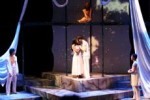Ripples of reflection

A naked actor playing “Man” emerges on stage with an astonishing splash from a huge pool of water. Amid the narration and visual depiction of the story of Chaos in the opening scene of the play Metamorphoses, it is not until Man emerges that the audience understands why the water on stage is important, why it is a tool used to symbolize how man and myth change.
Metamorphoses offers a balanced blend of theater and dance, utilizing the help of USF theater and dance faculty members Marc Powers and Michael Foley. The play presents a collection of stories from Greek mythology, ranging from Midas’ golden touch to Orpheus’ journey to the underworld. The production is presented as a narrative poem, set in and around an aquatic element. This strange, fluid aspect of the play seems foreign to a solid stage, but is undoubtedly the main attraction of the production. Playwright Mary Zimmerman’s production team needed an element that would aptly symbolize that process of metamorphosis. The large pool that dominates the central stage represents the transitional, malleable nature of water – an essential element that supports all life.
The pre-show introduction involves some performers playfully interacting with one another, some moving gracefully along the wooden catwalks bordering the pool, and some acrobatically using the long, vertical, white silks in a manner reminiscent of the Cirque du Soleil.
“It establishes a level of ceremonial respect that the performers have for the space and what they are doing,” Powers said. “It has a sense of continuity in setting the action for the intense activity in the pool, which becomes so dominant later on.”
As the character of Man emerges from the water wearing a royal robe, he transforms into King Midas. True to the tale, he is granted the golden touch by Bacchus. After he is bestowed the supposed gift, a curse turns his daughter into a statue.
The quick transition from Man to Midas subtly implies how Man is concerned with money and succumbs to being a “materialistic junkie – basically, a corporate toad,” Powers said.
No two myths are delivered through the same form of communication. Sign language, for example, is used to narrate the story of Orpheus and his journey down the river Styx to rescue his wife Eurydice from Hades. Four cast members position themselves on the pool’s edge with Orpheus’ character and tell the story through physical interpretation.
Ashley Enfinger, theater major and one of the four performers, used what she learned in her American Sign Language courses to her acting. “From the normal sign language perspective, it was interesting and much, much harder to learn the actual signs because Michael Foley choreographed every sign to every word,” she said.
In this myth, the audience sees the Lord of the Underworld as a large, dark and ominous puppet operated by the cast, who adds to the dramatic effect by echoing his lines.
The myth of Phaeton and his father, the sun god Phoebus, provides comic relief to the emotional and dramatic tone of the play. Zimmerman’s writing infuses the myths with modern and humorous elements. This casual atmosphere re-engages the audience, with language and dialogue working as an attention-grabbing device.
A particularly amusing scene involves a conversation between the teenage Phaeton – who is lounging in the pool – and his solar father Phoebus, who resides on Mount Olympus. Phoebus, in order to make-up for being absent during Phaeton’s childhood, grants him “the keys to his car,” a privilege the teenager is unable to handle.
“It is at the right point where we need a lighter moment,” Powers said. “It is a typical story of a spoiled little rich kid. It is the myth put into a contemporary metaphor.”
As the show draws to an end, the symbolism of the pool also changes in keeping with the theme of metamorphosis. The pool, initially the center of emotional and physical turbulence of the characters, changes so that its serenity conveys gentle, calmer messages toward the end. With the generous Philemon and his wife Baucis bending to the rage of Zeus and Hermes – the latter showering their blessings on the former – a theme of closure emerges. This is followed by Midas’ eventual appearance on the scene, which is now lit with lamps floating in the pool. He washes his hands for one final time and is reunited with his daughter.
“This final pool scene takes place in Midas’ home, suggesting that he shouldn’t have left it in the first place,” said Jesse Hutson, theater major and the actor playing King Midas. “What he was looking for was not outside, but on the inside.”
In the end, the performers blow out the lamps in a random pattern, serving as a hint that the play is not over, but is slowly fading out.
“I thought it was a really amazing production,” said Vanessa Taylor, theater major. “Walking in, seeing the set, seeing the performers playing with the silks – the whole atmosphere draws you in already. There is a simplicity about everything, but there also is a depth in the manner it is performed.”
Metamorphoses will play in Theatre 2 Wednesday through Saturday at 8 p.m., with an additional performance at 3 p.m. Sunday. Tickets are $6 for USF students and seniors and $12 for adults. Please be advised that this play has mature themes and brief nudity.






